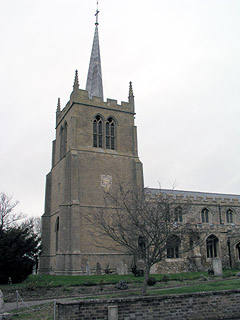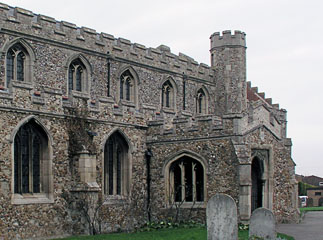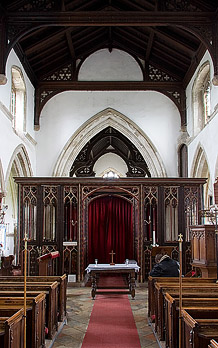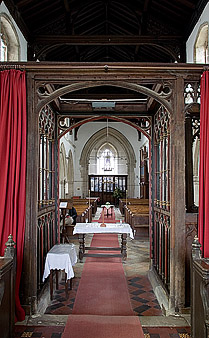This is a magnificent church, far outshining its humble neighbour at Steeple Morden. St Mary's sits squarely alongside the main street and is embellished in almost every possible way. The aisles are filled with tall windows and topped with battlements, as are the clerestory and chancel parapets. There's a tall octagonal stair turret on the south side, and the porch is a grand affair of the same date - all these are in the perpendicular style.
The tower is the most striking part. It is contemporaneous with the porch, but was built entirely of stone - a very rare thing in this stone-starved county. The proportions are grandly extravagant: broad and extremely solid looking, it has set back buttresses rising to the bell-stage, then little pinnacles on the corners. An elaborate base course decorates the base, and quatrefoil sound-holes punctuate the middle stages. The whole thing is topped by a great lead steeple. All very dramatic.
From the outside you'd be forgiven for thinking that this is an entirely Perpendicular building, and coming inside the impression is certainly the usual one of height and light. Nevertheless, there are signs of something older. The nave arcades, for example. There are six bays on either side (as I've said, this is a very big church) and most of them are 13th century. In the south arcade the style changes abruptly half way through - to the west the piers are rounded with quatrefoil-shaped capitals (like the north arcade) and to the east they are octagonal. These are the remains of a 12th century transitional-style building, a large one. This rather suggests that there has been a very big church on this site for a long time.
The historical evidence corroborates this deduction. The earliest mention of the church is late 11th century (though there must have been a church on the site before that in my opinion). The reference is in connection with Picot, first Norman sheriff of Cambridgeshire. Part of the Conqueror's establishment of himself in his new kingdom was the displacement of the saxon authorities in the counties, and their replacment them with his henchmen. No doubt some of these were good and diligent administrators, but many seemed to regard their appointment as merely an opportunity for their own enrichment. Picot was one of the most notorious - in the Liber Eliensis he is described by the monks of Ely as:
"a hungry lion, a prowling wolf, a crafty fox, a filthy swine, a dog without shame, who stuffed his belly like an insatiable beast as though the whole country were a single corpse".
This venom was no doubt prompted by the new sherrif's penchant for 'acquiring' ecclesiastical lands. Sometimes this was not purely for his own worldly ends however, and Guilden Morden might be a case in point.
Picot's wife, who rejoiced in the very 11th century name of Hugolina, suffered a dangerous illness and vowed that if she recovered a monastery would be dedicated to St. Giles. When the recovery came, on her behalf, Picot established a church with six canons near Cambridge Castle (it's successor is still there) - and Guilden Morden was one of the churches given to this new foundation. Was it originally part of the estate of the Abbots of Ely? We can't be sure, but it wouldn't surprise me.
As is obvious to the visitor, this 13th and 12th century core to st Mary has been transformed by a comprehensive Perpendicular makeover. All the windows in the church appear to date from that period, including those in the lovely clerestory.
The rooves also date from the same upgrade exercise. The nave roof is very fine - a noble arch-braced, tie-beam construction (I think) with elaborately pierced and carved plates in the spandrels of the arches. The chancel roof is even more magnificent, eight angels gaze serenely down from hammerbeams. The church guide implies that they are medieval, but I have slight reservations.
Pevsner (as is often the case) is rather useless and doesn't even mention them. I'd very much like them to be original: but the dreaded Dowsing visited here (on the Ides of March in 1643, no less). He doesn't mention them either - saying only that a cross was to be taken down and the altar steps levelled. Of course this could mean that the angels had been removed in an earlier wave of iconoclasm. [Mark adds: Or perhaps he just ignored them in his haste, he was busy that day, no less than eight churches vandalised of which Guilden Morden was the 6th - his actual record says that the cross and steps are to be dealt with by "the next Lent", which implies that he himself did not do anything during the visit.]
Between the nave and the chancel you cannot miss St Mary's greatest treasure. This is the spectacular rood screen - probably the most unusual one I've ever seen. It is a double structure, with two chapels (themselves enclosed entirely by wooden screens) flanking a passageway that passes under two arches into the chancel. I don't know of anything else like this in the country. It dates from the middle of the 14th century, and it is very richly decorated, painted in lovely dark green, red and gold, with very fine tracery in the openings.
The chapels are surprisingly capacious - about six feet deep by 4 wide - although only the north one is still used [Mark adds: the other has a collection of junk in it, flower arranging items and a hoover etc and looks surprisingly domestic, like an under-the-stairs cupboard]. Two paintings survive on the north side dado, where St Erkynwald and St Edmund peer out at you. St Edmund is a familiar subject to East Anglian eyes, but St Erkynwald (or Erkenwald) is less well known. He was an early bishop of London, appointed in 675 by St Theodore, and is believed to have built the first stone cathedral of St Paul's in his eighteen year tenure. He was also the brother to St Ethelreda, the foundress of Ely Abbey - maybe that supports the idea that this place once belonged to them.
When considering such an extraordinary structure it's natural to suspect that it may be a bit fraudulent, perhaps assembled from medieval fragments some time after the Reformation. Pevsner certainly thinks so, suggesting that the chapels are formed from reassembled parclose screens. There's certainly some evidence indicating that the parts of the screen enclosing the chapels are from a different period to the main screen across the chancel arch. A contrary piece of evidence is the painted inscription running along the dado, either side of the central passage. Foolishly, I forgot to take a note of the Latin, but an English translation was given in the north chapel. It reads:
Jesus in death's dark hour be thou my friend; My life to come make sure at this life's end; Grant me confession, Lord, before I die; and guide my parting soul to realms on high.
Rather a weedy Victorian translation... The lettering of this inscription looks decidedly medieval to me, making it unlikely these two panels could have been part of parclose screens disassembled later (that would mean the inscription was originally split over two sides of the church).
It's all a bit of a mystery to me, I'm afraid. Go and visit St Mary: the church is magnificent and the screen is intriguing and lovely. Then send me your answers on a postcard.
St Mary is kept open.





